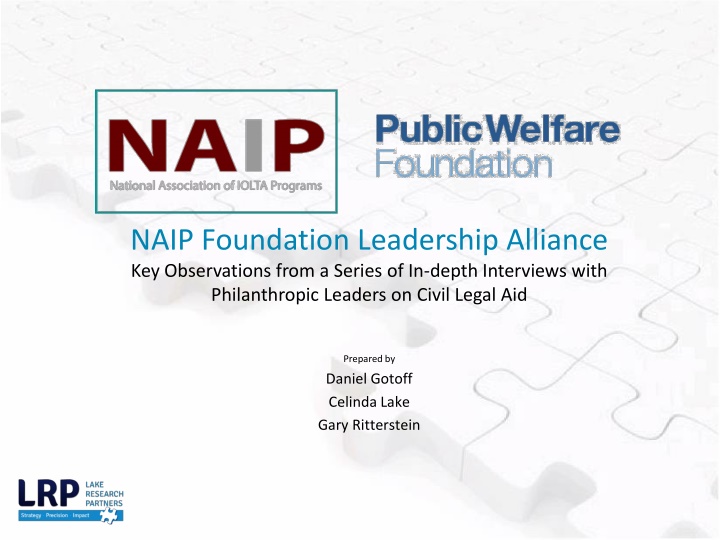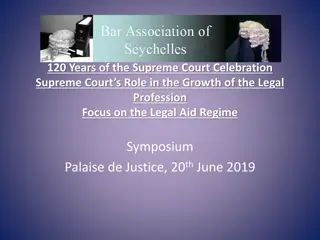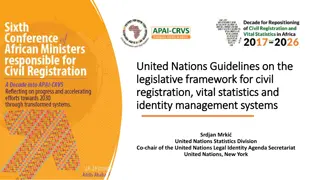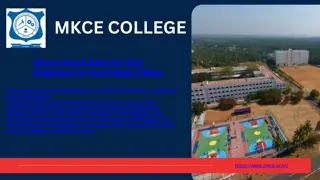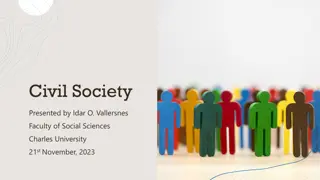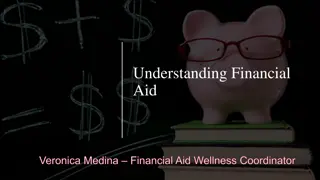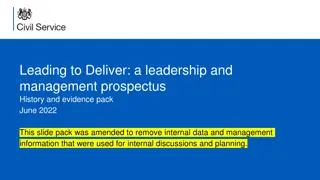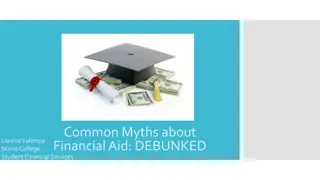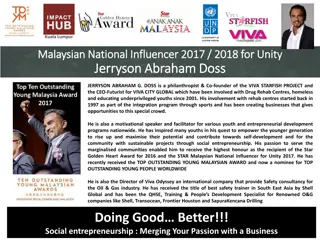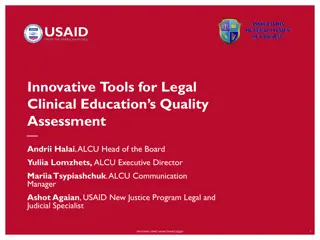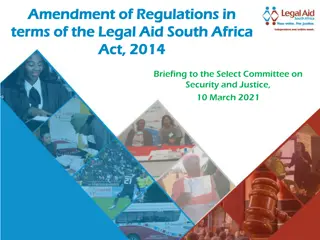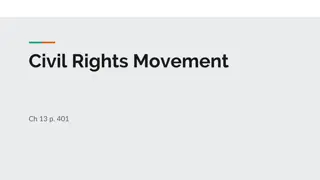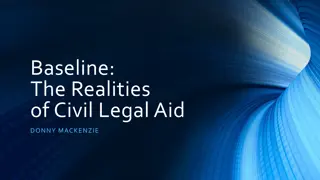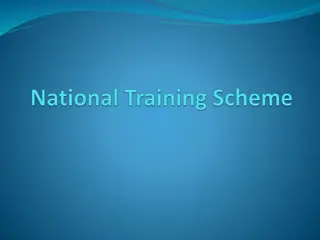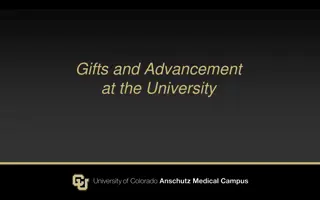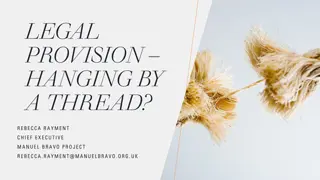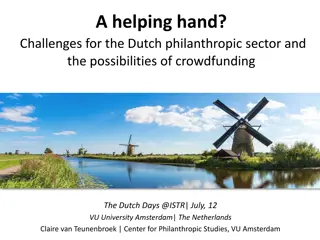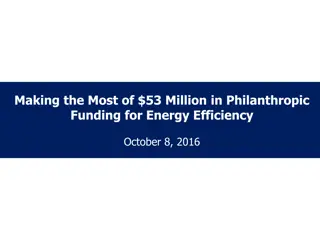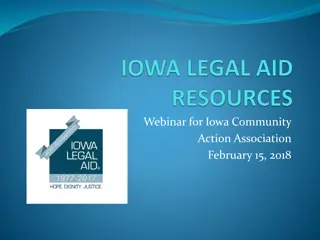Key Observations from Philanthropic Leaders on Civil Legal Aid
In this report, key insights derived from in-depth interviews with philanthropic leaders regarding civil legal aid are presented. The document, prepared by Daniel Gotoff, Celinda Lake, and Gary Ritterstein, sheds light on crucial perspectives and opinions shaping the landscape of support for legal aid among foundations and other stakeholders.
Download Presentation

Please find below an Image/Link to download the presentation.
The content on the website is provided AS IS for your information and personal use only. It may not be sold, licensed, or shared on other websites without obtaining consent from the author.If you encounter any issues during the download, it is possible that the publisher has removed the file from their server.
You are allowed to download the files provided on this website for personal or commercial use, subject to the condition that they are used lawfully. All files are the property of their respective owners.
The content on the website is provided AS IS for your information and personal use only. It may not be sold, licensed, or shared on other websites without obtaining consent from the author.
E N D
Presentation Transcript
NAIP Foundation Leadership Alliance Key Observations from a Series of In-depth Interviews with Philanthropic Leaders on Civil Legal Aid Prepared by Daniel Gotoff Celinda Lake Gary Ritterstein
Methodology & Limitations We conducted 17 one-on-one interviews with chief executives (7), program leaders (8) and board trustees (2) focused on what would get them to make funding for programs that provide civil legal aid more of a priority. Each person in the pool of all possible participants did not have an equal chance to be included; we recruited from a list provided by the NAIP Foundation Leadership Alliance of current and prospective supporters. Participants self-selected, which isn t random; those who respond to the invitation may show themselves to be somewhat more assertive than non-participants. In opinion research, the one-on-one interviews seek to develop insight and direction rather than quantitatively precise or absolute measures. Because of the limited number of respondents and the restrictions of recruiting, this research must be considered in a qualitative frame of reference; and should not be viewed as reliable or valid in the statistical sense. The reader may find that some of the information seems inconsistent in character upon first reading this report. That is because a participant may be misinformed or simply wrong in his or her knowledge or judgment, and we should interpret this as useful information about their level of understanding. 2
Strategic Summary: Research Takeaways You need to go find them, they won t come to you. o Philanthropists are willing to help but need to be more aware. o We need to build relationships with new foundations that aren t already with us, but could be. You ve got to be out there educating foundations with human examples and outcomes. o Avoid talking too much about legal process; showing foundations how funding civil legal aid serves their constituents is much more effective. o Emphasize the vulnerable populations served; messages about self-help and court reform don t resonate as well. If you meet one foundation, you ve met one foundation. o Tailor and customize your pitches to each foundation s unique focus one size doesn t fit all. o These foundations have a lot of competing priorities, many of which may overlap with funding civil legal aid. Draw linkages where you can. Enlist higher profile figures to reinforce the importance of supporting Civil Legal Aid. o Keep using Natural Allies to bridge the communications gap. o Lawyers are credible allies in this effort; no sense that foundations are put off by association. No clear distinction in message strategy by type of foundation among the messages tested, but Important to emphasize the funding crisis, the need for systemic reform, and the importance of ensuring justice for all. 3
Lessons Learned: In Broader Research Context Quite effective in this study as well as previous research among lawyers (with a varied history of involvement with Civil Legal Aid) was focusing on the funding crisis and the vulnerable populations served. o In contrast to voters and lawyers, philanthropic leaders were turned off by populist language about corporations taking advantage of ordinary Americans. Participants in this study worried that such rhetoric could alienate supporters in the private sector. Successful messages and themes that emerged from our previous voter research resonated with leaders in the philanthropic community: funding crisis, the need for systemic reform in the civil justice system, and assuring justice for all. o However, these participants were much more focused on protecting the most vulnerable populations, an approach that has proved less effective in engaging the broader public who worry that increased public support for Civil Legal Aid will impact their pocketbooks but not their access to justice. 4
Increasing Awareness About the Need to Fund Civil Legal Aid There seemed to be a lack of awareness about the positive and direct outcomes of supporting Civil Legal Aid and the crucial difference it makes for the groups on which these foundations are focused. But with the new administration, issues around immigration, healthcare and other looming funding cuts are increasing attention around the need for and importance of funding. This may be an important moment in which to expand the profile of Civil Legal Aid among philanthropic leaders.
Who said what? The Trump Effect: N/R EF: "At [this] particular moment of Trump it s particularly critical to democracy." Here s the Key: First capitalized letters indicate organizational group Family, Community, National / Regional (other) = N/R; Second capitalized letters indicates region East Coast = Ec, Northeastern = Ne, Southeastern = Se, Midwest = Mw; Third capitalized letters indicate funding F = current CLA funder or Nf = not a current funder (self-described)
Levels of awareness about Civil Legal Aid varied among organizational leaders. Those who have or currently support Civil Legal Aid services naturally tended to have a better understanding of the need, what it involves, and how it fits into the broader philanthropic landscape. foundations serving the immigrant community were among the most keenly aware of the growing demand, lack of funding, and severe impact of further cuts. Common associations included access to justice for all who cannot afford it (a perception that is shared by voters, too); domestic violence; the needs and challenges facing the elderly; families taken advantage of at home or at work; children being torn away from their loved ones; and reducing predation of vulnerable populations and barriers to self-reliance. More Common: N/R NeNf: Protection of rights Access to justice, representing helping them preserve their rights and navigate the complex system... Housing, family law, banking and consumer immigration... employment discrimination, wage theft. Family MwF: "This is a country that is supposed to be based on everyone having an opportunity to state their case and for proper representation; without kind of a network of Civil Legal Aid, that doesn't happen." Community MwF: We do a lot of work with.. new.. immigrant communities um and it comes through in a variety of different ways, so a lot of it is social service. Some of it could be education, health, there s so many different ways that we re working with different populations through the Immigrant Law Center.. CARE individuals, foreclosure, finance, protection, 7
Part of the reason that foundations may not prioritize the urgent need to fund more Civil Legal Aid services is that people in need are unaware of their rights, or that they may have a just claim or defense, until they encounter a serious civil legal situation. The absence of a feedback loop results in limited awareness and calls for support from current and prospective grantees. Community NeF: "I think that people often are unaware of the distinctions between a right to counsel in the criminal context, which means a right to government funded counsel and a right to counsel in the civil context which means you can have a lawyer, but the government is not going to pay for it. N/R WNf: I see a lot of people who don't even know what legal rights that they might have and they don't have any funds to sort that out. Family MwF: I think a lot of Civil Legal Aid assist people in areas where middle class people just sort of take care of the problem by themselves and assume that it is not so hard to get that problem taken care of they don't understand that low income people have a much, much harder time dealing with similar issues. 8
Philanthropic leaders are becoming increasingly aware of the importance of Civil Legal Aid since the recent election, agreeing they would like it to be a higher priority. But it is not yet a top tier focus for some it is a direct priority while for others it is more indirect and or even low to no priority at all. Community NeF: "we actually have a human justice strategy we have a set of explicit priorities around civil legal aid. I think, however, we are one of only two New York City based funders, who fund civil legal aid consistently. Direct Priority N/R WF: I think it should be higher than it is I envision it to be more because of the issues that we're facing post if Feds do pull funding from civil legal aid I hope we're going to be there." Family WF: "before November I would say less than 10 percent of the focus would be on civil legal aid related topic. Now all of a sudden it has become a major emphasis point but often not being called that." Indirect Priority N/R SeNf: It is important and actually we have done some work on that specifically it doesn't rise to a top priority just because everybody has issues they think are the most important ones. Community MwF2: "it s a low priority we ve made some small investments in some of the legal aid foundations... But I think kind of other health issues take precedence here in terms of how funding investments are made. Low / No Priority N/R WNf: now our priority is criminal justice reform.... interested in our investing more on civil want to see other foundations join us now with immigration... Trump Administration that s in power... forced to think more [about it]." 9
Key Barriers The major barriers that emerged included a lack of awareness, competing priorities, and a sense among some that no amount of funding could adequately offset decreased public support. Concerns about hiring lawyers or wading too deep into justice issues were minor at best.
A common criticism that emerged is that Civil Legal Aid organizations tend to focus too much on the legal process instead of the overall outcomes in meeting the needs of specific groups of people. Competing priorities emerged as a much bigger barrier to increased support for Civil Legal Aid among funders than non-funders. Lack of Awareness Competing Priorities Never Enough Bad Politics Family MwF: Our board felt this was not in as great a need for foundation dollars as other areas because the legal community was supporting it at significant levels . fairly narrow scope of services There are .. strategies that you could take on where legal services within a program area could be. N/R WNf: There s a lot of issues that a lot of folks are concerned about, but they don t know how that there may be civil legal issues involved in achieving some of those goals They just don t see the connection because they ve never been part of a discussion. Community MwNf: Not knowing that there s a need and question of sustaining, what other funding streams are involved the government will just continue to assist. Whereas there s never enough. Community SeNf: Getting pegged as liberal here is bad... Community tends away from justice issues important to level playing field less funding lawyers .. more upsetting system.. need to intersect with current focus (payday lending or polluters). 11
Criticisms for funding lawyers and frivolouslawsuits were not serious enough concerns to keep foundations from supporting Civil Legal Aid, however they may impact how funders talk about their support in certain settings. Community MwF2: The clientele that s being served by those attorneys, there would be no other means for support, and so I think the reputational risk is sort of manufactured... the kinds of cases that are dealt with are not frivolous. I mean it really affects people's livelihood, their ability to have a secure residence, a place to live or to fight an unfair eviction." N/R WNf: You know these legal aids, actually literally have thousands of people waiting on waiting lists. These are not people with frivolous lawsuits . Anything involved is actually very concrete, lawsuits that are tied to the work that the foundations really do. N/R WF: "Lawyers are really the heroes of our time at the moment; the way they stepped up to the travel ban, the way they continue to step up around deportations lawyers help us understand it and access it" 12
Several participants referred to the importance of highlighting victims and even the television program Law and Order , despite its focus on the criminal justice system, suggested to some an example of elevating and dramatizing the high stakes of serious civil legal matters. Family MwF: Individuals who ve been positively impacted... Toni Preckwinkle... Need celebrities... Law & order N/R NeNf: There might be a couple of the corporates like Verizon domestic violence is one of their issues and you can see the connection with that. Community MwNf: Different victim coalitions could possibly step into that role. preventing 13
Navigating Barriers to Greater Support for Civil Legal Aid It depends tell me who your organization serves and I ll share a story of how it helps. What s the best reason for my organization to support more Civil Legal Aid? If you meet one foundation, you ve met one foundation, in that you need to tailor pitches about the priorities and groups of people that each foundation serves one size doesn t fit all. You ll need to find foundations(they won t come to you).
Making the Case for Greater Support Pitch: Talk about Civil Legal Aid to others by highlighting that funders can achieve their broader goals of putting the groups they intend to serve on a path toward security, stability, and increased opportunity a decent job, access to health care, afford housing costs, and keep their families together. Some added that discouraging bad actors would be further reduce the need for services over time. o A re-occurring suggestion was to show more concrete examples of where access to Civil Legal Aid has made a pivotal difference in people s lives, as well as examples of further need. Validators: Contrary to the assumption that those closest to civil legal aid serve as the best messengers, we need to enlist more validators beyond just foundations we don t have enough. It was striking how many different types of figures would be effective, ranging from lawyers and foundation leaders to celebrities, politicians and those who could tell their own personal stories, especially youth and children. This isn t what we typically see with other causes. o Some suggested that hearing from prominent foundations that are not typically associated with Civil Legal Aid could add important validation too because they would be perceived as having been convinced from a similar standpoint. 15
Foundations are much more likely to support Civil Legal Aid services as an element of a broader initiative that focuses on a group of people they already serve. In the interviews, philanthropic leaders emphasized the importance of tailoring funding requests for Civil Legal Aid to each foundation as much as possible. Leaders in foundations that do not currently fund Civil Legal Aid services were open to funding advocacy campaigns, spreading the word to their grantees, and increasing support for grantees that support Civil Legal Aid services. N/R WF: "We are open for applications and so when they come in, if we see the link to our objectives [are] our own communities and foundations are telling us this is a solution for some of the issues that we prioritize... There's a planning process . We took a look at our track records external scans of what other funders are focused on.... we like to stay with the same issues for a while." Family MwF: We are actively looking to learn about and know the work in the city that is related to our grant making priorities. We do not actively look for work that does not fall within our grant making priority. . Community NeF: "I advise our board on grant making in K to 12 public school and human justice, which has evolved to be to a fairly large degree, grants for Civil Legal Aid... funds actually come.. ordinary and some not so ordinary New Yorkers.. who leave their money.. with a varying range of designated purposes... then we have others that are what we call unrestricted.." 16
Some common threads in how foundations would make their own case to others for supporting Civil Legal Aid included: access to justice, serving the vulnerable and lower income communities while benefit[ting] the broader community, as well as the program being a valuabletool that results in better outcomes and more productive contributing individuals, open[ing] the door to other services. Community MwF2: Any foundations that are really committed to serving vulnerable there is a role and a need for that work in communities that, you know are struggling and economically disadvantaged. N/R WF: Need Civil Legal Aid as part of... our arsenal of tools and resources... completes the ecosystem of supports for communities that we care about... not just for folks who can afford it, but to folks who can't." Family MwF: Providing legal services was a huge part or an essential part of addressing the underlying issue... we look for an organization that can be a central resource to help a broader community." and Family MwF2: A practical benefit is it opens the door to other services if you don't have access to legal status then some of the job training or educational opportunities aren't going to move them along a path to self-sufficiency." while 17
Message Testing: We Tested Six Different Messages What Works Well: The most compelling arguments for greater support for Civil Legal Aid emphasized the program s critical role in protecting the most vulnerable, with references to specific scenarios/issues, the impact on human lives, and the broader social change effected as a result. o Hearing validation from leaders in the philanthropic community also proved influential e.g. including quotes about what others have said. What Does Not Work So Well: The two least appealing messages were those that invoked anti-corporate David versus Goliath themes and those that emphasized aspects of improving the specific steps of the broader legal process. o Common concerns were that references to corporations sounded too ideologically liberal, focusing on legal procedures lacked enough tie into human outcomes, and that broad claims about impact were too impersonal and vague to illicit an emotional sense of urgency. 18
PROTECTS VULNERABLE WITH KRESGE QUOTE: Civil legal aid protects the most vulnerable. Civil legal aid groups provide legal representation for victims of domestic violence, families dealing with threats or neglect from absentee landlords, as well as children, seniors, and veterans who are denied access to health care or benefits. According to one funder, the Kresge Foundation, legal representation is sometimes all that is standing between a family s effort to be self-sufficient and poverty. If you need a car to get to a job and a predatory lender is making a claim on it, you need Civil Legal Aid or you may be out of work. AVG RATING: 2.4 (highest) Pros Family MwF: Very good.. gave really tangible examples.. I thought the example in the middle was probably the most broad and generic this question about repossessing a car in order to get a job, I thought that was an excellent example. More concrete examples humanize the problem and invoke emotional relation. The quote from the Kresge Foundation was perceived very positively by most it concisely sets up a powerful narrative, with villains, victims, and heroes. Some noted that the size and scope of the organization being quoted needs to vary based on the audience, but pushback on this front was minimal. Cons N/R SeNf: Didn't like about it at all is referencing the Kresge Foundation a huge foundation and very few foundations would put themselves in the same bucket... I like having a foundation in there, I just would be very careful about what I put in there because I think it matters. Still room for statements about unmet needs. 19
POLICY REFORM (SPECIFIC EXAMPLES): On the ground expertise in communities enables legal aid groups to lead broader social change. Legal aid efforts have been behind major reforms to rein in predatory lending, protect health benefits for disabled children, and improve job conditions for low-wage workers. Legal aid results in positive economic impacts. For example, by preventing eviction and foreclosure, legal aid offices saved an estimated $116 million in shelter costs in New York alone. And legal aid for abused women saves public costs on medical care for victims; counseling for affected children; and law enforcement and court costs for perpetrators. The list of examples goes on. Pros AVG RATING: 2.3 N/R NeF: Wow, that one I d give like a four because a lot of people in the foundation world want like data points and specific information on return on investment. So I think that this one does an even better job in giving precise examples and the actual costs justification for investment. Economic impact stats can have varying appeal among different foundations. Need to rephrase this message to be more powerful, but some good points. Cons Community SeNf: Providing story Providing cost savings so it s not a burden Resonates with people came out with economic study did business groups step up Less good broader social change as opening line can scare off people in conservative state... Sounds lefty. Consider more statements about reducing wrongful injustices. 20
FUNDING CRISIS: The facts are plain more people need legal aid now than ever, but the resources are not there and being reduced further. In the past decade, as poverty rates have risen the funding per eligible client has dropped by almost 60%. Today, legal aid programs must turn away two of every three people seeking services due to lack of resources. State and national studies estimate that a staggering 80% of serious legal needs of low-income people go unmet due to grossly insufficient funding and support. And it will only get worse, if the federal government eliminates funding to the Legal Services Corporation. Pros AVG RATING: 2 Family MwF: I think it is always good to put things in terms of unmet need, so quantifying that, especially talking about the growth of the poverty rate, growth of demand and how many folks are in need of services and not receiving them is a good, clear message. There are good, tangible facts here about unmet need for foundations that are less aware. Cons But given how big the problem is, participants wanted to know that additional funding can make a real difference, not just a drop in bucket. Community MwF: The numbers are compelling at the same time as I m listening to this I m thinking yeah and you could say the same thing with a lot of other areas, so I m wondering how compelling it s going to be. 21
TOOL FOR FUNDERS: Civil legal aid is an effective tool for funders, helping funders accomplish their goals in affordable housing, access to health care, education reform, income security, and programs serving children and families. Civil legal aid lawyers see the problems people face every day and they are able to use that knowledge to build broader advocacy strategies in areas in which funders are already engaged. As one philanthropic leader testified, Why would a health foundation be funding a bunch of lawyers? We fund community lawyers at legal aid foundations because they get results. They resolve specific problems and rigorously document client experiences and advocate for sensible policy and administrative changes that benefit everyone. Pros AVG RATING: 1.75 (more appealing to funders) N/R SeNf: Especially I like the part where you are talking about what it does for the fund. I think the part was what it is helping funders achieve their goals and that is kind of what I was getting at with the outcomes. This message drew more middling responses from philanthropic leaders, who felt it needed more specifics about outcomes rather than general thought arguments. Cons N/R EF: The only other thing I think that might be nice to include... is just to say that it compliments your other strategies.... lets the funder think they are already on the right track, so they are already doing a good job but they could even do more by expanding a little bit. It makes it feel less of a jump." Some suggested that explaining how Civil Legal Aid can complement an organization s existing efforts could be very effective. 22
DAVID VS. GOLIATH: Civil legal aid helps people without legal knowledge or resources stand a fair chance against big corporations, institutions, or the government. Those entities all have armies of lawyers at their beck and call to ensure they get what they want. Too many times people are forced to live with their rights trampled and their economic livelihoods put at risk simply because they cannot afford legal advice and help. Legal aid groups are a natural ally for philanthropists. Supporting them is a good tool for funder to use to achieve justice. Pros AVG RATING: 1.5 N/R EF: "I obviously work for a very progressive foundation so... it jives very much with their understanding of where the power is and this is a tool to try to get more power to people... I think that definition is going to be effective but you would really have to use it in a very targeted manner... the majority of funders are pretty middle of the road and that is not the lingo they use. While anti-corporate themes have real appeal among the public, philanthropic leaders urged caution about using a message frame that funders may find alienating or threatening. Cons Family MwF: Big individual donors often work for those big corporations or have stock in them, and a lot of board members of private foundations. There is probably a small group of foundations who are motivated by the idea of going after big bad corporations, but that is a fairly small population. There is a limited place for playing up a more populist theme with existing supporters who want to put power back in the hands of the people. 23
RESULTS-ORIENTED PHILANTHROPY: Investing to help people solve their legal problems is smart, results-oriented philanthropy. For decades, legal aid groups have been a driving force that makes change real in millions of lives. They have answers when families need housing, food, health care. It s their work that corrects bad policy and changes how society treats the most vulnerable. With limited funding, they are implementing innovative solutions to expand their ability to serve more people such as streamlined court procedures, simpler forms, online help, and self-help centers in libraries. Civil legal aid is the indispensable underpinning for much of the work funders already support. Pros AVG RATING: 1.2 (lowest) Community NeF: I think it did a good job of explaining the breadth of where Civil Legal Aid hits and what the practical impact is for people. I think the very end, about it being the underpinning is a little condescending to people who have not funded Civil Legal Aid in the past. Participants felt this argument contained too much at once, including points that could be better tailored to specific audiences. They also felt this lacked an element of emotional story telling. The emphasis on self-help tools also may underplay the aspects of Civil Legal Aid that participants (and the public too) view as paramount having a lawyer by your side in a serious legal situation. Cons N/R MwNf: It wouldn't make me want to jump out and say oh I need to start funding Civil Legal Aid 24
Just as important as the message, so too are the messengersincluding celebrities, industry leaders, and prominent foundations (with and without an established profile on civil legal aid) as well as those who can echo their efforts, including media and membership foundations with publications. N/R EF: "The media would probably cover some of the stories. Community NeF: The Federal Legal Services Corporation at this point is probably the leading collector of information on Civil Legal Aid... And then I think after that the interest on lawyer account funds.... I think certainly Kresge and Public Welfare Foundation have been working on this Civil N/R SeNf: Being part of a network or an association I think publications that foundations read and subscribe to and creating partnerships with multiple foundations that provide support services so not just us but then there are family foundation associations out there and there are other small associations. Legal Aid issue for a while. N/R SeNf: If Bar Foundations are out there providing support to Civil Legal Aid and know those services really well but can get out from under the Bar world and kind of speak more philanthropy than legal stuff... that other foundations would listen to. N/R WF: It'd be great if like non-legal funders say it I don't know if we would say it, but I mean it'd be great if like a big...like Robert Wood Johnson Foundation which is known for [its] health work. 25
Message Triangle Unmet Needs, Effective Investment Directly Impacts & Helps Most Vulnerable Civil legal aid protects the most vulnerable, providing legal representation for victims of domestic violence, families dealing with threats or neglect from absentee landlords, as well as children, seniors, and veterans who are denied access to health care or benefits. Legal representation can be all that is standing between a family s effort to be self-sufficient and poverty. If you need a car to get to a job and a predatory lender is making a claim on it, you need Civil Legal Aid or you may be out of work. More people need legal aid now than ever, but as poverty rates have risen the funding has dropped by almost 60%. Today, two of every three people seeking services are turned away due to lack of resources. It will only get worse if the federal government eliminates funding to the LSC. Even with limited funding, Civil Legal Aid programs can and are implementing innovative vulnerable communities such as streamlined court procedures, simpler forms, online help, and self-help centers in libraries. solutions to serve Civil Legal Aid Effecting Broader Social Change On the ground expertise in communities enables legal aid groups to lead broader social change. Legal aid efforts have been behind major reforms to rein in predatory lending, protect health benefits for disabled children, and improve job conditions for low-wage workers. Legal aid results in positive economic impacts. For example, by preventing eviction and foreclosure, legal aid offices saved an estimated $116 million in shelter costs in New York alone. And legal aid for abused women saves public costs on medical care for victims; counseling for affected children; and law enforcement and court costs for perpetrators. These are only some of the examples of Civil Legal Aid getting results directly impacting lives and effecting broader social change. 26
Appendix: Message Ratings & Summary Follows Washington, DC | Berkeley, CA | New York, NY LakeResearch.com 202.776.9066 Celinda Lake clake@lakeresearch.com Daniel Gotoff dgotoff@lakeresearch.com Gary Ritterstein gritterstein@lakeresearch.com Corey Teter cteter@lakeresearch.com Olivia Myszkowski omyszkowski@lakeresearch.com
Convincing Reasons to Support Civil Legal Aid Six Different Messages Rated on Scale of 0-3 Organization Types Message Titles National/Regional Family Community AVG. Protects Vulnerable/ Kresge Ex. 3, 3, 2 3, 1.5, 3 2.5, 3, 1 2.4 Policy Reform 2 1.5, 2 2, 4, 2 2.3 Funding Crisis 2, 2.5 2.5, 3, 2 2 2 Tool for Funders 2.5, 0, 3 2, 1 3 1.75 David/Goliath 2, 3, 0, 2, 1 1 1.5 Results Oriented 1, 3 1 1.5, 2, 3, 2 1.2 28
Message Summary: Top Talking Points The following lines resonated the most: Today, legal aid programs must turn away two of every three people seeking services due to lack of resources And it will only get worse, if the federal government eliminates funding to the Legal Services Corporation. Protects the most vulnerable victims of domestic violence, families dealing with threats or neglect from absentee landlords, as well as children, seniors, and veterans who are denied access to benefits. According to one funder, the Kresge Foundation, legal representation is sometimes all that is standing between a family s effort to be self-sufficient and poverty. Civil legal aid is an effective tool for helping funders accomplish their goals in affordable housing, access to health care, education reform, income security, and programs serving children and families lawyers see the problems and they are able to use that knowledge to build broader advocacy strategies in areas in which funders are already engaged. Legal aid efforts have been behind major reforms to rein in predatory lending, protect health benefits for disabled children, and improve job conditions for low-wage workers. 29
